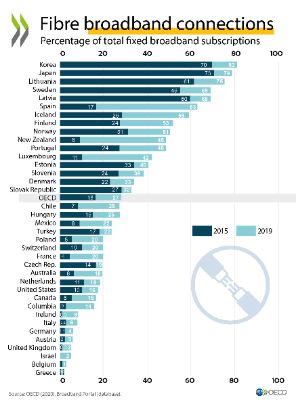COVID-19 Crisis Accentuating The Need To Bridge Digital Divides, Says OECD
Improved Internet connectivity and skills have helped many countries to cope with the health and economic crisis from COVID-19. Yet the pandemic has raised the bar for the digital transition and underscores the need to close the digital divides that risk leaving some people and firms worse off than others in a post-COVID world, according to a new OECD report.
With some Internet providers reporting increases in traffic of 60% since the start of the pandemic, as people adapt to living and working online, the OECD’s latest Digital Economy Outlook reveals the gaps between and within countries in access to fast and reliable Internet. For example, the share of fibre in fixed broadband subscriptions in OECD countries ranges from 82% in Korea and 79% in Japan to below 5% in Austria, Belgium, Germany, Greece, Israel and the United Kingdom, with high-speed connections often sparse in rural areas. OECD countries count roughly twice the level of high-speed mobile Internet subscriptions per inhabitant and three times the level of fixed broadband subscriptions as non-OECD countries.
Advertisement - scroll to continue reading“Digital technologies have helped our economies and societies to avoid a complete standstill during the COVID-19 crisis, and have enabled us to learn more about the virus, accelerate the search for a vaccine and track the development of the pandemic,” said OECD Deputy Secretary-General Ulrik Vestergaard Knudsen, launching the report at a virtual event.
“But the crisis has also accentuated our dependence on digital technologies and exposed the reality of the digital divides between and within countries. We are at a turning point in the digital transformation, and the shape of our economies and societies post-COVID will depend on how well we can progress and narrow these divides.”
The digital transformation was accelerating prior to COVID-19 as an increasing number of governments place digital strategies at the heart of their policy agendas. Surging demand for bandwidth-intensive communication services from e-commerce, teleworking, online social activities and increased cross-border collaboration by governments and academics should spur further progress. Today’s reliance on digital solutions has also added urgency to concerns around privacy and security by creating a fertile environment for cybercriminals.
Average mobile data usage per subscription in OECD countries already quadrupled in the four years to June 2019, and prices for high-usage mobile broadband fell by 59% over 2013-19, according to the report, which draws data from the OECD’s regularly updated Broadband Portal. As of June 2020, 5G commercial services were available in 22 OECD countries.

OECD economies counted 113 high-speed mobile Internet subscriptions per 100 inhabitants as of June 2019, up from 32 per 100 a decade earlier, while non-OECD countries counted 60 such subscriptions per 100 people.
Fixed broadband subscriptions number 32 per 100 inhabitants in OECD countries (more than three times the non-OECD level of 9 per 100) with fibre connections accounting for 27% of subscriptions. There are persistent gaps between rural and urban households in terms of availability of quality fixed broadband connections.
Prior to the pandemic, in 2019, only a quarter of firms with over 10 employees across the OECD made e-commerce sales, while a third of firms had purchased cloud computing services and more than half had a social media presence. The share of people using e-government services stood at 58% in 2019, up from 43% in 2010.
The share of adults using the Internet ranges from over 95% in some OECD countries to less than 70% in others. Gaps in Internet access or usage due to age or income level mean uneven access to public information and services, especially critical during a pandemic. In a future where jobs, education, healthcare and even social interactions may depend on digital technologies, failing to ensure widespread digital access risks deepening inequalities and hindering countries’ efforts to emerge stronger from the pandemic, the report says.
Governments can strengthen broadband deployment by promoting private investment and competition, encouraging infrastructure sharing and setting minimum levels of coverage for rural areas in spectrum auctions, the report says.
To meet the current surge in demand for network connectivity, the report recommends measures like temporarily releasing additional spectrum or approving commercial transactions that put unused spectrum into service, upgrading interconnection capacity between networks and finding ways to encourage broadband providers to deploy more fibre deeper into networks.
Download the complete OECD Digital Economy Outlook 2020
Download a 10-page summary: Digital Transformation in the Age of COVID-19
See more OECD work on the digital economy


 Global Jews for Palestine: Jewish Organisations' Passover Statement, After 40 Days Of Starvation
Global Jews for Palestine: Jewish Organisations' Passover Statement, After 40 Days Of Starvation APEC: Stronger Immunization Policies Needed As Vaccine Confidence Falls
APEC: Stronger Immunization Policies Needed As Vaccine Confidence Falls 350.org: Indigenous Groups From The Pacific, Brazil & Canada Hand Demands To COP30 Presidency To End Fossil Fuels
350.org: Indigenous Groups From The Pacific, Brazil & Canada Hand Demands To COP30 Presidency To End Fossil Fuels Conservation International: Conservation International Expedition Reveals Ecosystem Recovery In Tokelau
Conservation International: Conservation International Expedition Reveals Ecosystem Recovery In Tokelau UN Special Procedures - Human Rights: UN Expert Urges States To Finance Inclusive And Sustainable Development, Not A War Economy
UN Special Procedures - Human Rights: UN Expert Urges States To Finance Inclusive And Sustainable Development, Not A War Economy Amnesty International Aotearoa NZ: Global - Recorded Executions Highest Since 2015
Amnesty International Aotearoa NZ: Global - Recorded Executions Highest Since 2015